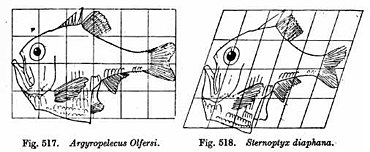
Biological or process structuralism is a school of biological thought that objects to an exclusively Darwinian or adaptationist explanation of natural selection such as is described in the 20th century's modern synthesis. It proposes instead that evolution is guided differently, by physical forces which shape the development of an animal's body, and sometimes implies that these forces supersede selection altogether.
Structuralists have proposed different mechanisms that might have guided the formation of body plans. Before Darwin, Étienne Geoffroy Saint-Hilaire argued that animals shared homologous parts, and that if one was enlarged, the others would be reduced in compensation. After Darwin, D'Arcy Thompson hinted at vitalism and offered geometric explanations in his classic 1917 book On Growth and Form. Adolf Seilacher suggested mechanical inflation for "pneu" structures in Ediacaran biota fossils such as Dickinsonia. Günter P. Wagner argued for developmental bias, structural constraints on embryonic development. Stuart Kauffman favoured self-organisation, the idea that complex structure emerges holistically and spontaneously from the dynamic interaction of all parts of an organism. Michael Denton argued for laws of form by which Platonic universals or "Types" are self-organised. Stephen J. Gould and Richard Lewontin proposed biological "spandrels", features created as a byproduct of the adaptation of nearby structures. Gerd B. Müller and Stuart A. Newman argued that the appearance in the fossil record of most of the phyla in the Cambrian explosion was "pre-Mendelian"[a] evolution caused by physical factors. Brian Goodwin, described by Wagner as part of "a fringe movement in evolutionary biology",[2] denies that biological complexity can be reduced to natural selection, and argues that pattern formation is driven by morphogenetic fields.
Darwinian biologists have criticised structuralism, emphasising that there is plentiful evidence both that natural selection is effective and, from deep homology, that genes have been involved in shaping organisms throughout evolutionary history. They accept that some structures such as the cell membrane self-assemble, but deny the ability of self-organisation to drive large-scale evolution.
Cite error: There are <ref group=lower-alpha> tags or {{efn}} templates on this page, but the references will not show without a {{reflist|group=lower-alpha}} template or {{notelist}} template (see the help page).